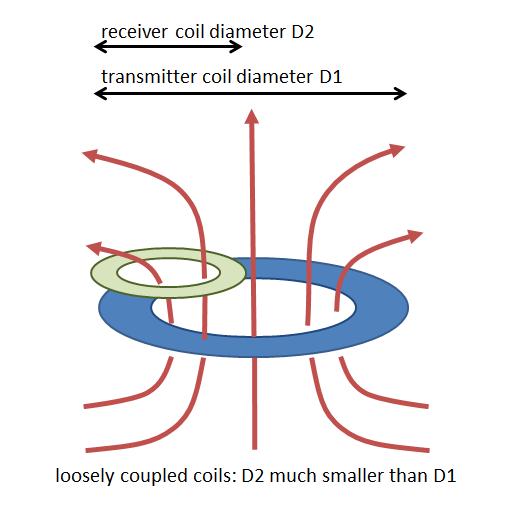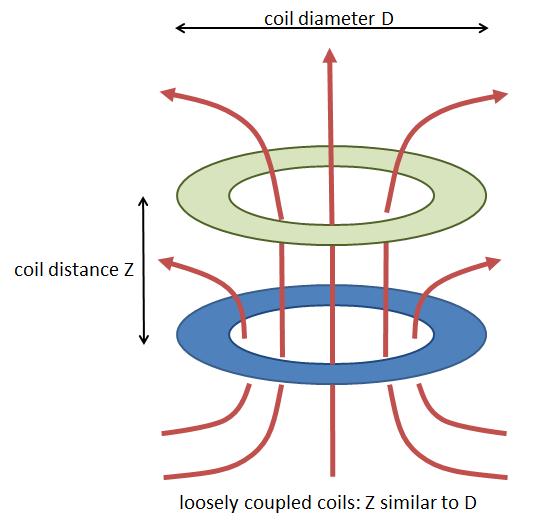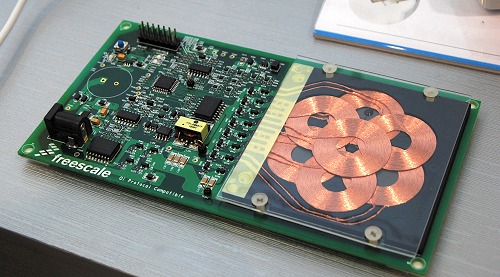The State of Wireless Charging Standards in Mobile
by Andrei Frumusanu on April 2, 2015 8:00 AM ESTInductive Coupling - The Basics
With the history of wireless charging out of the way, the remaining is question is how does it all work? To start, we need to understand the basics of inductive coupling.
Power transfer of inductive coupling happens by creating an alternating magnetic field on the transmitter coil, that magnetic flux is then converted into an electrical current in the receiver coil. The generated electrical current depends on the amount of flux generated by the transmitter coil, and how much of a percentage the receiver coil is able to capture. The distance, size, and positioning of the receiver coil relative to the transmitter coil decides the “coupling factor” of the two coils.
A higher coupling factor means a more efficient power transfer through loss reduction and less heating. In general, we differentiate between tightly coupled and loosely coupled systems.

Source: WPC
In tightly coupled systems, the transmitter and receiver coils both are of the same diameter size and aligned with each other with a minimal distance in-between them. This setup ensures most of the magnetic flux is captured by the receiver coil to be able to be converted into an electrical current.
Loosely coupled systems are defined by setups which do not capture all of the transmitter’s flux, either because the receiver coil distance is too big, or because the coil diameters don’t match and the receiver coil is smaller than the transmitter coil.


Source: WPC
While we mention loosely coupled systems and we’ll get back to them short when investigating Rezence charging, both WPC and PMA standards based on tightly coupled systems.
Optimal alignment of the transmitter to the receiver coil is crucial for a high coupling factor and high efficiency power transmission; because of this, there is a problem of practicality to actually achieve this alignment. To alleviate the issue, Qi transmitters allow for multiple transmitter coils that may overlap.

Source: WPC
By employing multiple transmitter coils over each other, we have a greater area of “optimal coupling” over which a device can be placed on. The control IC of the charging system will then detect which coil is best suited for the power transmission and then use that one for generating the magnetic flux. It is also possible to power on multiple coils simultaneously to achieve a higher power transfer if the receiver device is designed for it.
WPC & PMA Power Control
In Qi and PMA based systems, control over how the coils are powered is done via data communication between the transmitter and the receivers. This is done via data modulation (Either amplitude or frequency based) on the power carrier frequency. The in-band communication requires advanced signal processing and this is where manufacturers’ solution ICs come into play.
WPC wireless power functional diagram, Source: Texas Instruments
This communication is also the main difference and source of incompatibility between the Qi and PMA standards, as without a reliable and interoperable signal the charging process will not start. Powermat differs to Qi by using RFID handshake instead of modulation on the power signal.
The direction of power transfer is always from power transmitter to power receiver. The transmitter idles with in a low power state, which depending on vendor is in the 60mW range. When the power receiver detects a transmitter, it identifies itself to the transmitter as a compliant device and sends configuration information such as the desired charging power. Once power transfer is initiated, the receiver can send error packets requesting more or less power. The power transmission stops upon either receiving an “End Power” message or a period of non-communication of 1.25s.
The coils of a WPC-compliant device operate as resonant half-bridge on a 50% duty cycle with a 19V(±1V) DC power input. Depending on power demand, the frequency in the coil is modulated between 110 and 205 kHz. Powermat on the other hand works in the 277-357 kHz range.
On the receiver side, WPC gives the manufacturers much more liberty in terms of coil-design. While the transmitter is required to have a certain size and provide certain power for standard’s sake, the receiver is allowed to vary in size to adapt to the device form factor the system is implemented into.
Qi in its first low-power specification allows up to 5W of power transfer, with a revision on newer charging systems allowing up to 10W.
Unfortunately PMA does not publicize the standard’s specifications to non-members, so we don’t have any finer details on how it compares to Qi. It’s nevertheless safe to assume that the basic principles of the two standards work in similar fashion.











90 Comments
View All Comments
retroneo - Friday, April 3, 2015 - link
The 6 and 6 Plus are big enough that they could include both Type-C and lightning. Hopefully they do that at least for a year or two.rtho782 - Friday, April 3, 2015 - link
USB chargers are more common than Qi mats. So, I have one at my desk, one at my bed, one in my car, and it does take 2 seconds, and I can charge my phone while using it, much faster (Qualcomm quick charge).Qi means buying a mat for each of these locations, note that I still need the USB charger to power the mat. It charges slower, it takes up desk space, and if I pick my phone up, it stops charging.
Plugging a USB cable in isn't that much hassle. This is a solution in search of a problem.
uop - Thursday, April 2, 2015 - link
Agree with you about plugging in being a non-issue.However imagine how much sleeker your phone would be without a USB port at all!
mr_tawan - Friday, April 3, 2015 - link
Sony has been releasing phones without usb exposed for quite sometime. It's hidden inside a flap. And if you're using cradle to charge I'd say it's almost 0 needs for using USB. Besides putting phone on the cradle takes almost the same time as using wireless charger (although it can charge only one device at time).I haven't touch the flap on my Z1 for months now (last time I do is to install a custom firmware).
MobiusPizza - Tuesday, April 7, 2015 - link
It's not just about laziness. My Sony Xperia Z is water proof, and getting access to the USB port for chargning is not only a hassle, but repeated opening/closing of the plastc flaps actually reduce the water proof capability to a point the water seal no longer works. A wireless chargning standard enable true water proof phones.mchart - Friday, April 10, 2015 - link
This is why they all have the magnetic charger poets. A $5 adapter on your USB cable and you never have to open the flap. Further, it's easy to use. I'd rather have all phones have magnetic connectors rather then wireless.nandnandnand - Thursday, April 2, 2015 - link
http://www.tomshardware.com/news/ossia-cota-wirele...zodiacfml - Thursday, April 2, 2015 - link
This is what I have been thinking since the first wireless charger. I don't know where I got the idea, maybe from an article that you could get power from Wi-Fi albeit very low power.Anyway, I'd prefer this method as the smartphone is always being charged and could get the power in real time from the wireless signal. It wouldn't need compete with wired charging or any other wireless charging for serious charging as this only lengthens the independence of a device from a charger throughout the day.
Yet, a lower power device might not even need the serious chargers except in emergencies.
Cinnabuns - Thursday, April 2, 2015 - link
Absolutely agree with blanarahul. I never really thought about this issue until I accidentally stumbled upon it. I got a Nexus 4 for myself and my wife at the same time. 2 months in, my wife gave me a Qi charger for my phone, but not for hers. Since then, I've charged my phone everyday with the Qi charger while she charged over USB.At the end of the phones' lives (2 years from purchase), my screen time on my Nexus 4 was an incredibly bad 50 minutes - 1 hour before my battery died. My wife's phone was much closer to 2. (Nexus 4 had pretty mediocre battery life even when it was brand new). My phone was consistently warmer during charging than my wife's phone because of the inefficiency of wireless charging. Those few degrees make a big difference if you value longevity in your batteries.
iamezza - Friday, April 3, 2015 - link
Firstly your sample size is 2 phones, also the phones may have been the same, but the usage of each phone (how much you drain the battery each day) was not controlled.I have a nexus 4 over 2 years and 4 months old and the battery is still good.
Also the Qi charger itself has an effect on the efficiency and heat produced.
Qi works best for certain usage scenarios while USB is better for others.
Wireless is best for keeping your battery topped up during the day while sitting at a desk or while being on the road - you need to put the phone in a dock anyway.
USB is best for when you drain your battery over your daily usage and then just plug it in on the night-stand to give it a full days charge.